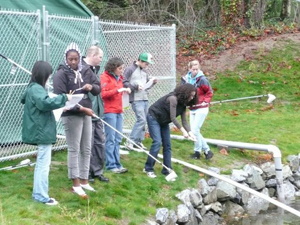Featured Golf News
Links as Labs Program a Success

Students from a Garfield High School environmental science class are all looking up at the big nest in a tall fir tree next to a par-3 at Broadmoor Golf Club in Seattle. A bald eagle is staring back at them, watching their every move.
"Usually there are two around the nest this time of year," said Broadmoor superintendent Sean McDonough. "Which means what?"
The kids have figured it out even before McDonough supplies the answer: "Mating."
Welcome to Links as Labs, a program started in 1997 by the First Green Foundation in conjunction with golf course superintendents. Links as Labs is an innovative environmental outreach program that brings high-school students to golf courses to test ground water, take soil samples, view wildlife and learn about their ecological surroundings.

In conjunction with First Green president Bill Meyer, Spokane Country Club superintendent Jeff Gullikson started Links as Labs. It struck Gullikson as a win-win for everyone involved.
"Teachers can apply what they teach in the classroom, students love to get out of school, and superintendents get to show what we do," Gullikson said.
Since the program began, more than 127 schools and 8,000 students have participated across the state. "The best thing about the program is that we get to show kids that golf courses are good for the environment," said Glendale Country Club superintendent Steve Kealy.
Interlake (Bellevue, Wash.) High teacher Lynn McKay regularly takes her environmental science classes to Kealy's course. Students have helped redesign the banks of Kelsey Creek, planted annuals and hung flower baskets at Glendale.
"It's a different classroom, there aren't four walls," McKay said. "It's fabulous, it's like this wonderful place to play on, to learn on. It's such a cool thing to get students out in what is basically a big park. It's a valuable learning experience for the kids. I've never had a kid who has not enjoyed it and learned a lot."
Links as Labs takes McDonough back in time to his childhood home in Boring, Ore., where he lived on Mountain View Golf Club. He saw the maintenance crew and thought he'd like to work on a course someday. At the time, he was taking science classes, and Links as Labs brings it all together for him. McDonough studied in the turfgrass management program at Oregon State and worked at Persimmon in Portland, the Resort at Coeur d'Alene in Idaho, Tacoma Golf and Country Club and Useless Bay on Whidbey Island (Wash.) before becoming Broadmoor superintendent in 2004.
"It's an opportunity for students to work with superintendents to see the benefits of golf in general, and we can show how and why golf courses are beneficial to the environment," McDonough said.
He used Broadmoor as an example. If the golf course didn't exist, McDonough speculated that a strip mall filled with business and asphalt would be here. That would be ecologically damaging to Lake Washington, further polluting its waters. But Broadmoor, with its 123 acres, acts as a huge environmental filter between Lake Washington and the 315 homes in the neighborhood.
McDonough is about to lead the Garfield students around his course. But they've got to finish their lunch first. That's another fun thing about Links as Labs at Broadmoor - free pizza and pop.
At Spokane Country Club, Gullikson cultivates junior golfers by letting them hit balls. "Most golfers pick up the game in high school," he said. "It's broken down some barriers."
Gullikson puts 15 flags on a green 150 yards away and tells them if they can get a hole-in-one on any of the holes, he will give them a free set of clubs. No one has made a hole-in-one yet, but someday someone will. Either way "it's a day they're going to remember," he said.
Gullikson estimates that he has spoken to more than 100 teachers and taken 50 to 60 classes on tours of his course. Students at Spokane Country Club use computers that measure evaporation and inform the superintendents when watering is required. They also learn that maintenance crews check soil moisture all day long.
"Students learn what golf courses are and what they're not," Gullikson said. "There's a perception that we contaminate water and over-fertilize and over-irrigate."
It's simply not true. Technology helps superintendents gauge what's needed. They don't gorge their courses, they spoon-feed them and consequently benefit the environment.
At Broadmoor, students follow McDonough to a retention pond from Lake Washington that is used to irrigate the course. They test the water and found no nitrates. It's a positive sign. "They're doing a good job of keeping the water uncontaminated," said Courtland Jimerson, a sophomore in Heather Snookel's Garfield environmental science class. "Fish could live there."
Nnabueze Njoku, a junior in Snookel's class, appreciates learning the names of trees. Field trips like these reinforce what she's learning in class. "It's a good application of what we're trying to teach," said Stephanie Durrant, who is teaching Snookel's class while Snookel takes maternity leave. "We get to do science in nature, which is really exciting."
For more information about the program, visit www.thefirstgreen.org and click on "Links as Labs."
Jim Moore is now a freelance writer after a lengthy run as a sports columnist for the Seattle Post-Intelligencer, which closed its doors in March 2009 after 145 years. He's a 51-year-old 12-handicapper with a pair of 4-year-old sons who love golf, too. Jim believes that the most necessary element on all golf courses is the presence of a beverage-cart girl, preferably two, one for the front side and one for the back. Jim is a mental midget who got so sick of his left wrist breaking down on the greens that he now putts one-handed. Jim can be reached and harassed at jimmoorethego2guy@yahoo.com.
Story Options
 |
Print this Story |
